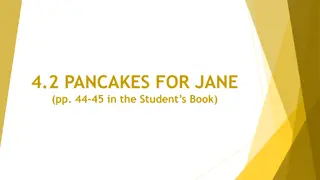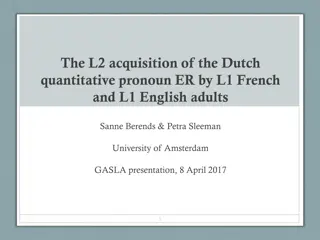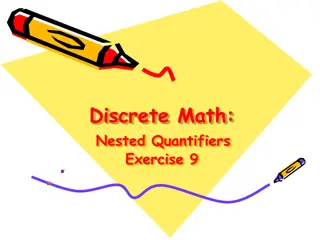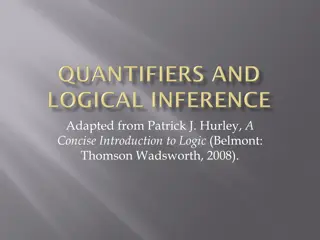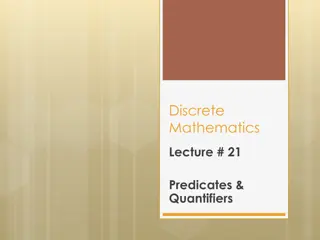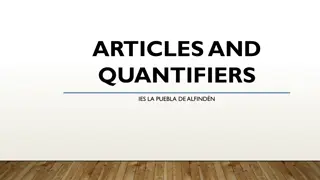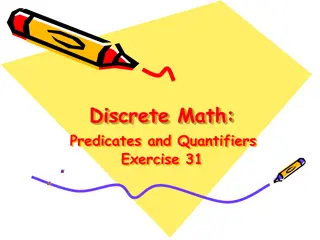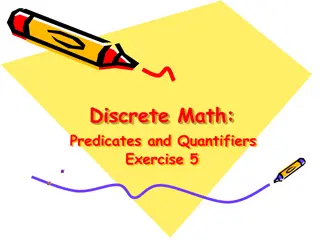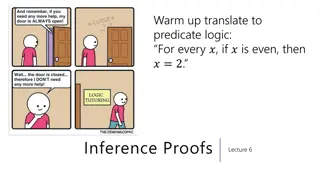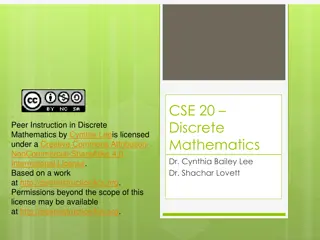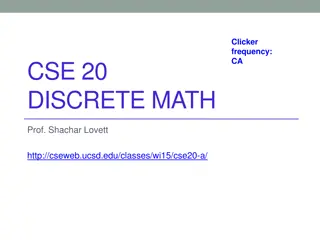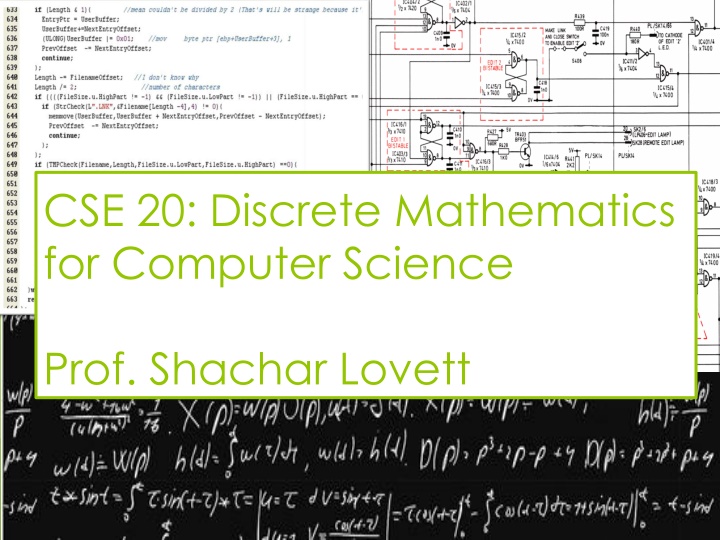
Discrete Mathematics for Computer Science: Predicate Quantifiers and Proof Strategies
Explore predicate quantifiers and proof strategies in discrete mathematics for computer science with Prof. Shachar Lovett. Topics include predicate quantification, paradoxes, nested quantifiers, and more. Learn about proving or disproving quantified statements and disprove predicates using counterexamples. Dive into the world of predicate logic and proof techniques.
Download Presentation

Please find below an Image/Link to download the presentation.
The content on the website is provided AS IS for your information and personal use only. It may not be sold, licensed, or shared on other websites without obtaining consent from the author. If you encounter any issues during the download, it is possible that the publisher has removed the file from their server.
You are allowed to download the files provided on this website for personal or commercial use, subject to the condition that they are used lawfully. All files are the property of their respective owners.
The content on the website is provided AS IS for your information and personal use only. It may not be sold, licensed, or shared on other websites without obtaining consent from the author.
E N D
Presentation Transcript
CSE 20: Discrete Mathematics for Computer Science Prof. Shachar Lovett
2 Today s Topics: 1. Predicate Quantifiers 2. Domain 3. Paradoxes
3 1. Predicate Quantification Sometimes and all the time.
4 I m going to assume you know this from the reading: For all even numbers x and y, the sum of x and y is also even. ?,? ?, ? + ? ? There exists an integer g such that g is greater than 5. ? ? ?.?. ? > 5
5 We re going to focus on: Nested quantifiers/more than one quantifier General strategy for proving (or disproving) quantified statements
6 Which picture represents the predicate? (Predicate Love(x,y) means x loves y , denoted by arrow from x to y) A. B. C. D. None/more/other
7 Which picture represents the predicate? (Predicate Love(x,y) means x loves y , denoted by arrow from x to y) A. B. C. D. None/more/other
8 Proof strategies overview (more coming later in the quarter) For a universally quantified ( for all ) statement: To prove it: Mathematical induction, direct proof, generalization from the generic particular (construction) To disprove it: Provide a single counterexample For an existentially quantified ( there exists ) statement: To prove it: Provide a single example To disprove it: State the correct version as a universally quantified statement ( For all x, not P(x) ) then prove it using above methods
9 How could we disprove the predicate? (Predicate Love(x,y) means x loves y ) ? ?.????(?,?) A. By counterexample: show there is a person who loves everyone B. By counterexample: Show there is a person who loves no one C. By counterexample: Show there is a person who nobody loves D. By counterexample: Show there is a person who everyone loves E. Other/more/none
10 What is the correct negation of the predicate? (Predicate Love(x,y) means x loves y ) ? ?.????(?,?) A. ? ?.~???? ?,? B. ? ?.~????(?,?) ? ?.~???? ?,? C. D. ? ?.~????(?,?) E. Other/more/none
11 2. Domain Know thy universe
In which domain is the following true? x y.x y A. All real numbers. B. All integers. C. All real numbers less than or equal to 5. D. All real numbers greater than or equal to 5.
In which domain is the following true? x y.x=y2 A. Integers B. Fruits C. {0,1} D. {1,2} E. None/other/more than one
In which domain is the following true? x y z.x=yz A. Integers B. Fruits C. {0,1} D. {1,2} E. None/other/more than one
Common number systems we will encounter in this class Integers = ,-3,-2,-1,0,1,2,3, Even, Odd Naturals = 1,2,3 Rationals = numbers which can be written as p/q, where p,q are integers (1/2, -2/3, 4/13, ) Non-rationals = Numbers which are not rationals (e, , )
In which domain is the following true? All cows are white A. USA B. England C. France D. This room E. None/other/more than one
17 3. Contradiction and Paradox Q: Do you like CSE 20? A: Yes and no.
18 Is this sentence true? This sentence is false. a) TRUE b) FALSE
19 Liar s Paradox This sentence is false. This has been perplexing people since at least the Greeks in 4th century BCE (2300 years!) What are some key features of this that make it a paradox?
20 Is this sentence true? This sentence is true. a) TRUE b) FALSE
21 Grandparent Paradox (Time Travel Paradox) You travel back in time and prevent one pair of your biological grandparents from ever meeting each other (assume this prevents your birth). Now who will go back in time to prevent your grandparents from meeting? Pop culture version:
22 Pinocchio s Paradox
23 The Barber A certain town has only one barber (a man). Every man in the town is clean-shaven. For each man m in the town, the barber shaves m if and only if m does not shave himself. Question: Does the barber shave himself? YES NO Not enough information Other a) b) c) d)
24 List Organization Question (aka Russell s paradox) Suppose you have many lists and some of your lists are lists of lists (to help you organize your lists), and some lists even include themselves. You make a list of all lists that do not include themselves, called NON-DANGER-LIST. Question: Should NON-DANGER-LIST include itself? YES NO Not enough information Other a) b) c) d)



